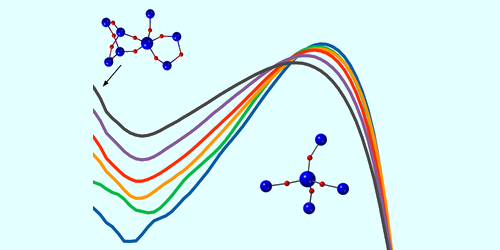Defects Control Silica’s Viscosity
As a glass-forming liquid cools, the jostling of its particles slows, and the material becomes more viscous. In some liquids, the viscosity increases smoothly as the temperature decreases. In others, including water and some metallic liquids, the viscosity-temperature behavior is more complex. The source of this complexity, which involves an initially large viscosity rise followed by a much more gradual change, remains unclear. Now, Zheng Yu of the University of Wisconsin-Madison and his colleagues predict that the temperature dependence of silica’s viscosity is linked to thermally activated crystal-like defects that form in the liquid as it cools [1]. The finding could lead to more precise control of liquid silica in glass fabrication.
For their study, Yu and his colleagues used machine-learning-based simulations to examine liquid silica’s temperature-dependent flow behavior. Their simulations assign to each of the liquid’s silicon atoms a probability that it will change position, or “hop,” relative to its neighbors. From the hopping probabilities, the model then estimates how many atoms flow through the liquid at a given temperature.
The simulations reveal that liquid silica’s complex viscosity-temperature behavior arises from a switch in the probability that the atoms hop. Hopping is promoted by defects in the liquid, analogous to point defects in a crystal. The number of these defects drops quickly as temperature decreases, leading to a steep drop in the likelihood that an atom hops and to a rapid rise in the liquid’s viscosity. Below a certain temperature, the defects completely disappear. The likelihood of the atoms hopping then follows a slow decrease, and the viscosity increase switches to a gradual rise.
–Rachel Berkowitz
Rachel Berkowitz is a Corresponding Editor for Physics Magazine based in Vancouver, Canada.
References
- Z. Yu et al., “Understanding the fragile-to-strong transition in silica from microscopic dynamics,” Phys. Rev. Lett. 129, 018003 (2022).




